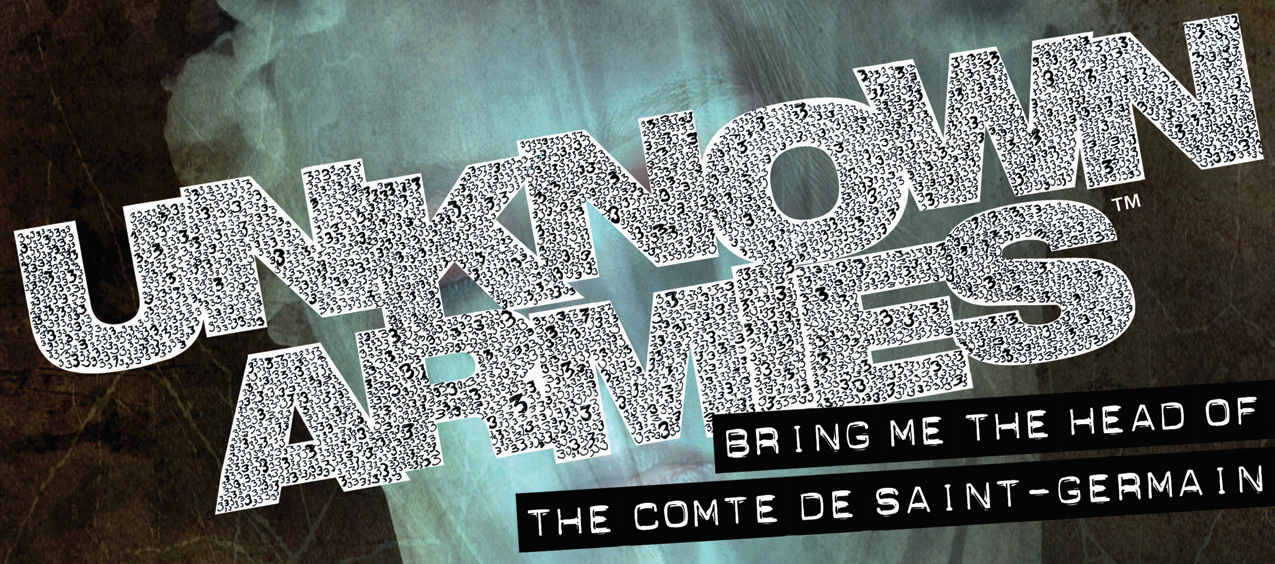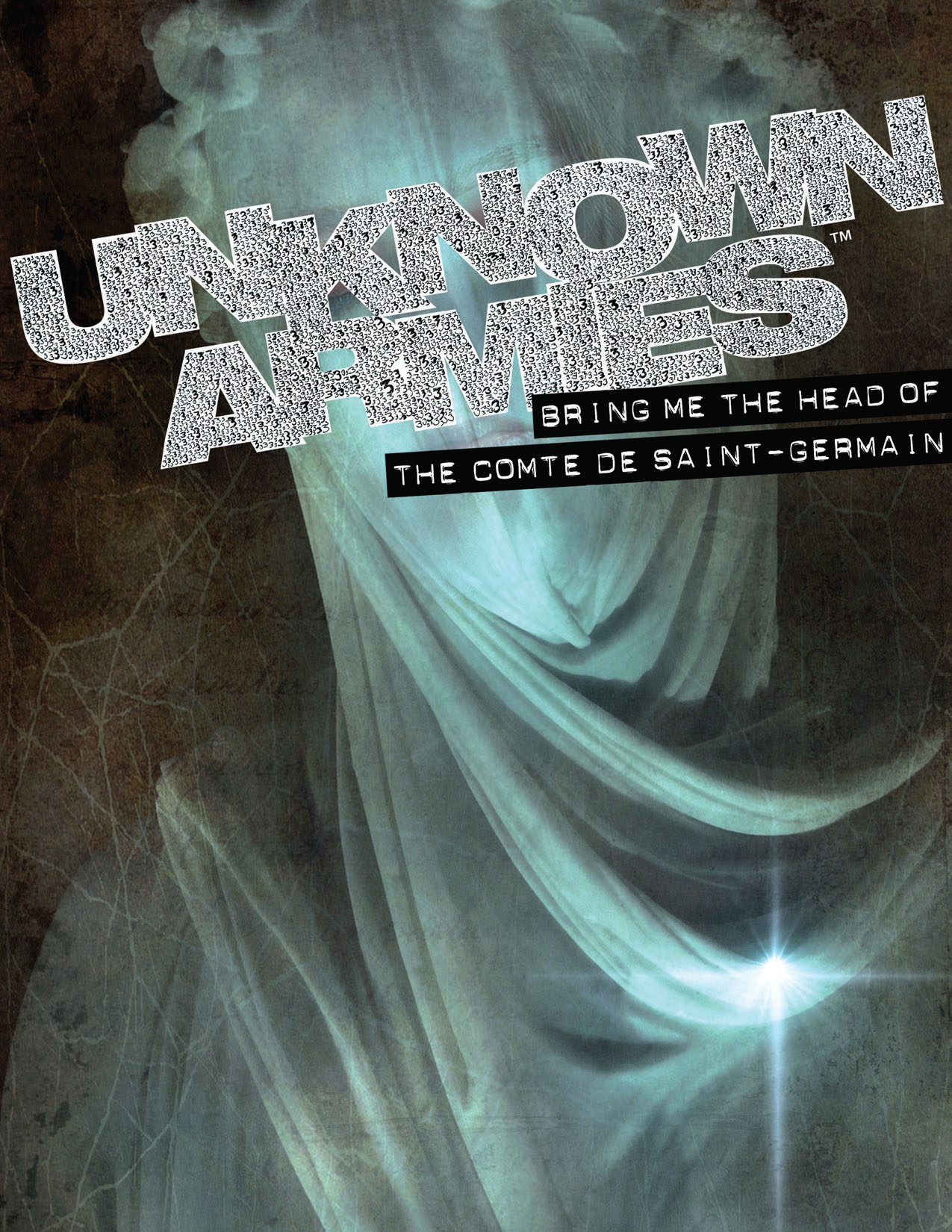Four factions. Two cabals. One 600-pound head.
In 2003, the universe got rewritten and the Comte de Saint-Germain — arguably the most important human to ever exist, the Once and Future Eschaton of the Invisible Clergy — got his brain scrambled. Now the race is on to retrieve the huge stone religious bust in which some of his memories are locked up.
That head was dug up and stuck in a museum in Québec, but now there are at least two different groups looking to steal it, another looking to steal it from whoever steals it first, and a fourth that would rather the head stay right where it is.
Can the players steal it? Defend it? Steal it back again? It’s all up to them.
Bring Me the Head of the Comte de Saint-Germain is a three-part mini-campaign for Unknown Armies by Greg Stolze. It reveals (and revels in) some of the deepest secrets of the setting and has several really cool features:
- It’s designed to be either seamlessly slipped into an ongoing campaign or picked up and run with zero prep using the deliciously well-developed pregenerated characters.
- The players actually swap roles between the protagonists and antagonists.
- There’s a really fantastic, full-featured heist scenario that kicks everything off.
- Multiple, flexible finales give the GM support no matter which way the players torque the adventure.
As the producer, I basically had nothing to do with any of this. It was a pleasure to just step back and let Stolze work his magic, while I focused on facilitating the presentation and design of the final book to maximize its utility and present Stolze’s work in the best light possible.
But if you take a peek at the credits page, you will notice that I do have an “Additional Writing” credit. This is for one very specific addition to the text, and like the extra in a Broadway play who walks through the background of a rainy scene and tells his parents the show is about a man with an umbrella, that’s what I’m going to be talking about today.
ON EXHIBIT
As I mentioned above, the opening hook and adventure for Bring Me the Head is a heist. Specifically, the PCs are stealing a huge stone head from Le Museé de la Civilisation Américaine in Québec. This was fully developed by Stolze:
- Blueprints (including a diagram of security cameras)
- Fully detailed security measures
- Detailed breakdown of entrances, locations, etc.
- Guidelines for handling likely methods of moving a 600-pound stone head
And so forth.
This is where my one addition comes in: I wrote up exhibit lists for each of the exhibit halls in the museum.
For example, here’s the one from the Autochtones des Plaines (First Peoples of Canada) exhibit:
- A stuffed bison
- Rifles used by Ojibwe and Dakota hunters
- TV playing videos of Ojibwe, Dakota, and Cree people, both contemporary scholars and interviews from the early 20th century
- A child’s jacket with embroidered Dakota floral patterns
- Beaded bandolier bags
- Nooshkaachi-naagan (Ojibwe winnowing tray) for separating grain from chaff
- A turtle-style cekpa ozuha (umbilical cord pouch) which served as a child’s first toy and a lifetime charm against death
I even ended up doing one for the souvenir shop (with some tie-ins to the various exhibit lists):
- Tiny replicas of Augusta Savage’s busts
- Plastic Mixtec jewelry
- A poster facsimile of the Canadian constitution
- Commemorative coffee cups
- Stuffed bison and caribou toys
- T-shirt that reads “Je suis venu au Québec et je n’ai reçu que ce t-shirt français”
Unknown Armies uses a sidebar reference system, so these lists are positioned in the sidebars where they won’t clutter up the primary text, but are readily available to the GM while running the scenario.
I felt having these lists in the book was important because, based on playtests, it seemed that these specific details were:
- Difficult for GMs to improvise on the spot (often resulting in generic responses like “there’s a lot of modern art in this gallery” instead of specific details); and
- High-value in terms of improving play.
First, the specific details tended to make the museum feel more “real” to the players. It also provided some meaningful color to flesh out onsite surveillance ops and some well-defined, “Oh shit! The exhibits!” moments if/when fighting broke out during the heist.
Second, this kind of specificity can serve as a launchpad for player improvisation. I don’t know exactly what the players might cook up with the hodge-podge of stuff in the souvenir shop, for example, but it will be interesting find out.
Third, expensive items can provide temptation to PCs who might want to snag something extra during the heist. This actually pivots off a suggestion that Stolze had already made in the adventure:
How honest are your PCs? If the answer is “not very,” they might take the opportunity to steal secondary stuff, either to distract from the stone head, or to resell, or just because it seems nice. Anything of great value escalates the pursuit considerably. Stat up a private detective with no occult knowledge but lots of resources to dog the PCs’ tail.
(The text is in bold there because guidance for the private detective is also given as a sidebar reference.)
Having specific potential targets in the various exhibits makes it more likely that one of them will catch the eye of a PC (or otherwise become featured in their plans).
Ultimately, this adheres to the Principles of Smart Prep: Identifying high-value material that’s difficult or impossible to duplicate through improvisation.
And that’s basically it. It’s a small detail, but particularly when multiplied across the hundreds or thousands of GMs who will run these adventures, I think it can make a big difference.














I was lucky enough to get to play this last summer for the UA tournament, and had a blast as Dr. Angel.
The only constructive feedback I had was that I found the mechanism by which Dr. Angel’s “power” worked damned near inexplicable, and watching the other playthroughs in the tournament, it seemed I was not alone in being perplexed as to how to actually get it to work in-game – most of the Dr. Angels seemed to struggle with how it was supposed to work.
When I got to look at the pdf (thanks, Atlas!), it didn’t appear that the actual mechanics of using it were cleared up. As the producer, do you know if anyone else raised concerns about it? Or was I just stupid? Or was it clarified and I missed it?
(Intentionally being vague to avoid anything spoilery.)
And for anyone on the fence about this – grab it – it’s fantastic!
Great article as always, just one thing: the link to the mini-campaign directs to the amazon page of “Ptolus City by the Spire”
FYI, the link from the title and the tiny “PDF” link at the bottom go to “Ptolus City by the Spire: Hardcover – Import”, not your book.
(IMHO you’re totally allowed to do a bigger “this is my book you should buy it” message, also. 🙂
The PDF edition is available from Atlas Games’ own shop, here: https://www.atlas-games.com/product_tables/AG6046
Links fixed! Thanks for the heads up!
I would be fascinated to see your take on GMing advice for this *weird* module. Or at least a fair-game spoiler thread.